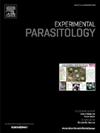生物phalaria glabrata (Say, 1818)作为血管圆线虫的副噬宿主(Baillet,1866)
IF 1.6
4区 医学
Q3 PARASITOLOGY
引用次数: 0
摘要
血管圆线虫寄生于狗的肺动脉和心脏(最终宿主- DHs)。各种软体动物作为中间宿主(IHs),通过摄入和/或渗透第一阶段幼虫(L1)而感染,随后发育为第二阶段幼虫(L2)和第三阶段幼虫(L3),后者感染DHs。此外,副生殖宿主(ph),如青蛙、鸡和老鼠,可以携带L3。本研究旨在评估光斑生物phalaria glabrata是否可以作为血管棘球蚴的PH,确定其潜在的渗透途径、迁徙途径以及感染后不同时间点的组织学改变。采用Baermann技术,在接触1000l1血管小蠊30 d后,从光斑小蠊软体动物体内回收L3幼虫。回收的L3用于感染光斑贝,数量为100个L3+ (L3来自先前感染过100个L3的软体动物)。在软体动物组织中检测到血管棘球蚴活的和活动的L3+,表明它们对L3+感染具有容忍度。其他受感染的软体动物在10%福尔马林中固定进行组织学分析,发现存在幼虫,且倾向于头足部区域。对于L3+的存活率,我们给两只杂交犬喂食含有L3+的犬粪本文章由计算机程序翻译,如有差异,请以英文原文为准。

Biomphalaria glabrata (Say, 1818) as a paratenic host of Angiostrongylus vasorum (Baillet,1866) Kamensky, 1905
Angiostrongylus vasorum parasitizes the pulmonary arteries and heart of dogs (definitive hosts - DHs). Various mollusk species act as intermediate hosts (IHs), becoming infected through ingestion and/or penetration of first-stage larvae (L1), which subsequently develop into second-stage larvae (L2) and then third-stage larvae (L3), the latter being infective to DHs. Additionally, paratenic hosts (PHs), such as frogs, chickens, and rats, can harbor L3. This study aimed to assess whether Biomphalaria glabrata could function as a PH for A. vasorum, identifying potential larval penetration routes, migratory routes, and histological alterations at different time points post-infection. L3 larvae were recovered from B. glabrata mollusks 30 days after exposure to 1000 L1 of A. vasorum, using the Baermann technique. The recovered L3 were used to infect B. glabrata, with the number of 100 L3+ (L3 obtained from mollusks previously infected with 100 L3). Viable and motile L3+ of A. vasorum were detected within mollusk tissues, demonstrating their permissiveness to L3+ infection. The other infected mollusks were fixed in 10% formalin for histological analysis, revealing the presence of larvae, with a tendency in the cephalopodal region. Regarding the viability of L3+, two mixed-breed dogs were fed canine pâté containing L3+, and L1 larvae were detected in their feces. This study demonstrates, for the first time, the potential of B. glabrata to function as a PH in the A. vasorum cycle.
求助全文
通过发布文献求助,成功后即可免费获取论文全文。
去求助
来源期刊

Experimental parasitology
医学-寄生虫学
CiteScore
3.10
自引率
4.80%
发文量
160
审稿时长
3 months
期刊介绍:
Experimental Parasitology emphasizes modern approaches to parasitology, including molecular biology and immunology. The journal features original research papers on the physiological, metabolic, immunologic, biochemical, nutritional, and chemotherapeutic aspects of parasites and host-parasite relationships.
 求助内容:
求助内容: 应助结果提醒方式:
应助结果提醒方式:


